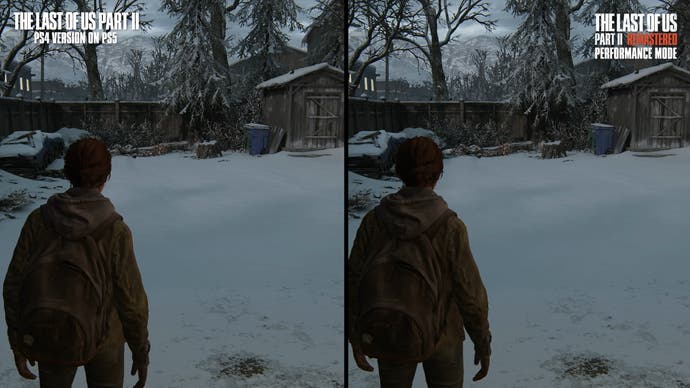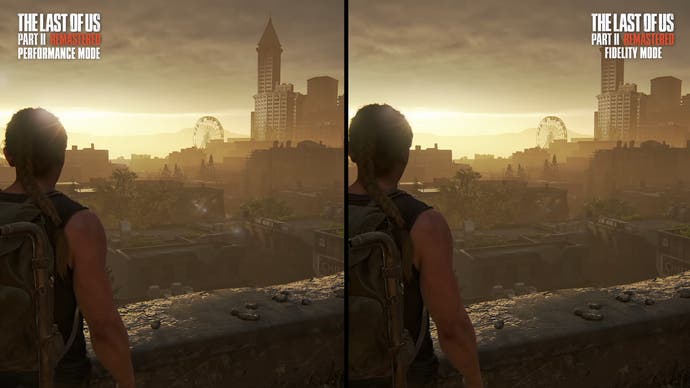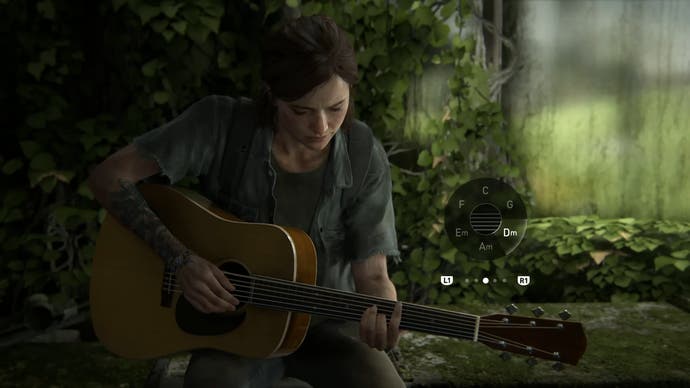The Last of Us Part 2 Remastered delivers an accomplished upgrade for PlayStation 5
The best way to play a genuine classic.
The Last of Us Part 2 was a stunning game when it launched for PS4 in 2020, a visual tour de force that showcased the best of Sony's first-party efforts at the tail end of the last console generation. A patch in 2021 added 60fps support for PS5, with a transformative impact on gameplay, but now we've got something further: The Last of Us Part 2 Remastered, a new bespoke PS5 version that promises visual enhancements alongside additional content.
Going into this analysis, I wanted to find out if there's enough performance headroom on PS5 for visual improvements while keeping up that 60fps update - and whether the new content additions are meaty enough to justify an upgrade for existing players, even at a fairly painless $10.
After all, the original TLoUP2 enhancements for PS5 already have the game running at 1440p and 60fps - so how much extra can developers Naughty Dog push on the same hardware?
The basic visual setup in the Remastered version is very familiar, at least by default. We're getting a 1440p60 experience in the default performance mode, just like the earlier patched code, with no signs of dynamic resolution scaling (DRS) or upsampling evident. Side-by-sides suggest that the two versions are a match in terms of basic image quality, with a similar, slightly soft resolve. If you look closely, you can spot some aliasing here and there, but for the most part the two releases seem perfectly fine, especially when seen from a typical TV viewing distance.
By far the largest settings difference between the two titles lies in their handling of foliage. The foliage in the original code has some very obvious pop-in and level of detail compromises, showing less dense foliage at a distance that doesn't animate. On the remastered version, we don't see nearly as much pop-in during traversal, and areas distant from the camera have better foliage coverage. The Last of Us Part 2 mostly takes place in grassy, outdoor environments, so these level of detail enhancements actually make for a pretty big improvement in most areas.
The PS Store description of the game also highlights improved shadow quality and texture quality, which are pretty tough to spot. Shadow aliasing and flickering from the PS4 release is more or less replicated heere, and the presentation of shadows appears nearly identical between the two versions. I spotted one hanging container with a noticeably higher-resolution shadowmap on PS5, but I couldn't find significant differences elsewhere.


I similarly struggled to find any texture quality differences between the PS4 and PS5 code, despite dozens of close-range captures, with the sole exception of a dirt texture that looked higher resolution in the Remastered version. Like with the shadows, I wouldn't expect a wholesale improvement here, but perhaps tweaked assets show up very occasionally. Texture filtering, though, does receive a noticeable upgrade, causing distant ground detail to resolve with less blur.
Beyond those differences, I was able to locate some tweaks that seem to show up on a scene-by-scene basis. A lamp in an early cutscene, for instance, is a lot brighter in the PS5 code, which I think looks more realistic. Similarly, in a bar scene, the patrons seem to have proper capsule shadows along their feet. In a couple of gameplay scenes, I noticed that the slight depth of field effect at a distance was absent in the new version. Perhaps the most obvious change is a shot in the opening cutscene, where Ellie's model appears different with de-emphasised eyes, different highlights on the eyes and skin; the shot has been reframed too. In other flashback sequences though, the Ellie model looks identical across the two versions.
Overall, the two versions of The Last of Us Part 2 look fairly similar. Naughty Dog has definitely tweaked and touched up some aspects of the game's visual presentation here and there, but players shouldn't go in expecting a broad visual uplift relative to the patched PS4 code that we've had for the last two-and-a-half years. The biggest upgrade here over playing the game on a PS4 system is still the ability to play at 60fps, which the Remastered version and the patched version of the original both offer on PS5 systems.


There's one other visual mode here, a fidelity mode, which should offer extra visual enhancements over the performance mode we've been looking at so far. Settings-wise, the key divide here comes down to output resolution: fidelity mode targets a full 4K, a substantial upgrade from the 1440p resolve in performance mode, though the frame-rate target drops to 30fps when at 60Hz output. In actual head-to-head comparisons though, I think it's not as big of an upgrade as you might expect.
Both modes resolve an image that's largely free of aliasing in typical play, with higher internal pixel counts than we're used to from many current-gen titles. From a typical viewing distance though, the difference between a straight 1440p and 4K isn't profound. The 4K resolve does come with a certain clarity that the performance mode lacks however, handing in a sharper rendition of fine details like blades of grass.
Beyond the resolution differences, the ambient occlusion sometimes takes on a noticeably different appearance in the fidelity mode that isn't necessarily preferable to the original presentation. I didn't spot any noticeable tweaks in LOD settings, volumetrics resolution, shadow resolution, texture filtering, or any other common tweakable between the two modes either. This approach is roughly what we observed in the other current-gen Naughty Dog titles as well, so there's no great surprise here.




For this analysis, I replayed roughly the first two thirds of The Last of Us Part 2 on hard difficulty to get a good sense of the typical performance players can expect - and I think the results are very good, with a smooth 60fps update throughout the content I sampled including big firefights. Cutscenes are a slight exception, where the game holds a frame on camera cuts for TAA purposes. Elsewhere, the game runs at a perfect 60fps as far as I can tell.
This was largely the case as well with the PS4 version running on PS5. The most prominent exception was a construction site shootout sequence, as John noted in his coverage back in 2021 (video embedded below). Here, the game occasionally dropped a few frames at a time while engaging enemies. Curiously, the Remaster runs this sequence just fine, without any frame-rate drop whatsoever.
The fidelity option is unsurprisingly a near-perfect 30fps lock too. More demanding sequences breeze right on by on the PS5 here, without any frame-rate dips as far as I can tell. Cutscenes are an exception again, and the 33ms held frame is definitely more noticeable here than we see in the performance mode, but it's not too distracting.
If you start the game with 120Hz output toggled to automatic and VRR off in the PS5 settings and enable the unlocked toggle in the game settings, the game will attempt to render at 4K 40fps rather than the usual 30fps. This mode actually does a pretty good job of hitting 40fps in typical play, with most gameplay hugging the 40fps line. Certain alpha effects - particularly those from infected enemies - can tank the frame-rate a bit at close range, and the water seems to hurt performance sometimes as well, but in general play those issues don't pop up very much. It's definitely a better experience than the fidelity mode at 30fps.
If you enable both 120Hz and VRR, you can play both modes with a truly unlocked frame-rate, smoothed out with variable refresh. The performance mode typically seems to run around 75fps to 100fps, while the fidelity mode seems to run around 40fps to 60fps. Both modes appear to have identical visual settings to their 60Hz counterparts, too. In a game like this without dynamic resolution, I think enabling VRR makes a lot of sense as there's usually quite a bit of performance headroom that goes unused otherwise.
Loading times have also seen a big improvement. In the patched PS4 code on PS5, loads tended to average 45-50s, although on some occasions I noted loads of up to ~90s. The new remastered version appears to load into chapter markers at about ~16s, a huge improvement. It's not earth-shattering speed relative to what we're used to from native PS5 releases, but definitely fast enough given that there are no loading screens beyond that initial one. It's clear that the game's real-time cutscenes are carefully designed to move data around as needed for future gameplay, even for the older PS4 systems.

Finally, there are a couple of additional configurables worth noting. The field of view can now be modified, with a pretty decent spread between the lowest and highest values to suit different tastes. The DualSense haptics and trigger feedback can be adjusted extensively too. One interesting feature here that's turned off by default is the speech to vibrations option, which seems to basically feed speech sound waves through the DualSense haptics like a speaker, which is a cool effect.
The Last of Us Part 2 Remastered also includes some additional content that wasn't present in the original release. There are three gameplay sections that were cut from the original game, which are accompanied by in-game developer commentary. I think these are interesting additions for fans of The Last of Us, and they are in perfectly playable shape with pretty detailed artwork. Completing them all took maybe 30 minutes or so, so I wouldn't say this is a long-term draw for the remaster.
There's also a guitar free play area accessible from the main menu, where you can use a few different kinds of guitars, selecting chords with the sticks and strumming with the DualSense touchpad. This is an amusing little diversion that builds on these sequences from the main game, but probably won't amount to more than a curiosity for most players. There's also a trailer for Grounded 2, a documentary on the making of The Last of Us Part 2 that will be released at some point as a special feature in the remaster itself.

By far the biggest addition here is the new No Return game mode. This is a sort of roguelike horde mode spin on The Last of Us, in which the player completes short wave-based single-player levels, building up to an ending boss battle. If you die, you have to start again from the beginning. Progress unlocks new characters and new modifiers, but everything else is reset.
I enjoyed messing around here, and I think the combat fares quite well when combined with the tension of permadeath. It's not really something that I'd go back to very much - I'd probably rather just replay the main story, which has a lot of the same combat areas anyways - but I'm sure some players will get a kick out of it. Given the cancellation of the TLOU multiplayer title, this is probably the only new substantial chunk of The Last of Us game content we'll see for quite a while.
Beyond the new additions and tweaks, I think The Last of Us Part 2 itself is worth revisiting for a few moments here. The game is almost four years old at this point, and was developed around a console that launched a decade ago, but I still think the visuals look superb. The environmental artwork, character rendering, and animation is still top-class stuff even today, and the overall presentation is striking with some truly stunning moments.

That isn't to say that there aren't any last-gen concessions - like a very heavy reliance on baked lighting - but the onscreen results typically look excellent. Precalculated lighting definitely has its limits, and the lightmap resolution could be higher for sure, but TLoUP2 achieves very good results. The real-time bounce lighting from the player flashlight is a nice touch too, and gives the lighting a sense of dynamism and interactivity missing from a lot of modern titles.
Reflections are handled using a mix of cubemaps - which are very well aligned here - combined with screen-space reflections, and capsule reflections for characters, with the occasional planar mirror reflection in the mix as well.
I think the game plays excellently too. The Last of Us Part 2 is an action-stealth hybrid, with the player scrounging for resources and improvising on-the-fly to survive combat encounters. There's something wonderfully tactile about choking out an enemy, or landing a headshot on an unsuspecting soldier. Being able to go prone and slip through gaps in buildings greatly expands player freedom in some of these combat encounters, and the gameplay arenas are large and well-built.
The Last of Us Part 2 also tells a unique and highly emotionally-charged story, which builds on the original game without simply trying to iterate on the existing plot. I'm not going to spoil anything here, but it just feels masterfully built, from the narrative framing to the way character motivations are examined and the story unravels, and of course it's built on a rock-solid technical foundation, with outstanding character detail and facial expression.
The Last of Us Part 2 is one of my favourite last-generation titles, and more than anything else I think this remaster is a great opportunity to revisit it, or play it for the first time. From a technical perspective, the game is in better shape than it's ever been before, and the new content additions are welcome.
This remaster is also available as a $10 USD upgrade for existing players, which feels worthwhile in my opinion for anyone who enjoyed the game the first time around, or $50 for new players. This isn't a full-on remake like The Last of Us Part 1, but it's not being priced at that level either. Ultimately then, The Last of Us Part 2 Remastered is a very successful, though not boundary-pushing, game remaster. This is simply the best way to play one of the most accomplished last-generation titles.




















